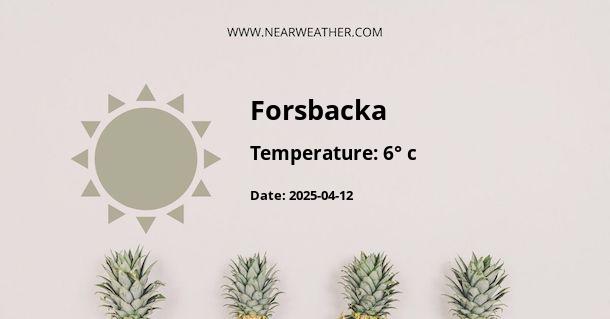Forsbacka, Sweden: Climate and Weather Year Round
Forsbacka is a picturesque town located in the Gävleborg County of Sweden. Situated near the River Gavleån, Forsbacka offers a stunning natural landscape that attracts both locals and tourists alike. Understanding the climate and weather patterns of Forsbacka is essential for anyone planning to visit or settle in this beautiful location. In this article, we will explore the climate and weather of Forsbacka throughout the year, providing detailed information to help you plan your activities accordingly.
Geographical Location
Forsbacka is positioned in the central part of Sweden, approximately 20 kilometers southwest of Gävle, the largest city in Gävleborg County. The town is situated at a latitude of 60.6867° N and a longitude of 17.0354° E. Its proximity to the Baltic Sea heavily influences the local climate and weather conditions.
Climate Classification
Forsbacka experiences a humid continental climate, characterized by four distinct seasons - spring, summer, autumn, and winter. This climate type is commonly found in the interior regions of Europe, where the influence of the ocean is limited. The Köppen climate classification for Forsbacka is Dfb.
Temperature
The temperature in Forsbacka varies significantly throughout the year, with warm summers and cold winters. Here is a table showcasing the average monthly temperature:
| Month | Average Temperature (°C) |
|---|---|
| January | -6.4 |
| February | -6.6 |
| March | -2.5 |
| April | 2.9 |
| May | 9.1 |
| June | 15.1 |
| July | 17.0 |
| August | 15.5 |
| September | 11.2 |
| October | 5.9 |
| November | 0.4 |
| December | -4.0 |
As seen in the table, temperatures in Forsbacka can drop as low as -6.6°C in the winter months (January and February) and rise to an average of 17°C during the peak of summer (July). It is important to note that these values are averages and actual temperatures may vary from year to year.
Precipitation
Forsbacka receives a moderate amount of precipitation throughout the year. The distribution of rainfall is relatively even, with no distinct dry or wet seasons. Here is a chart displaying the average monthly precipitation:

From the chart, it can be observed that Forsbacka receives an average of around 50-60 mm of precipitation each month. The wettest months are typically July and August, while the driest months are February and March. Snowfall is common during the winter months, contributing to the overall precipitation levels.
Sunshine Hours
Forsbacka experiences varying amounts of sunshine throughout the year. The number of sunshine hours can significantly impact outdoor activities and overall mood. Here is a table displaying the average monthly sunshine hours:
| Month | Average Sunshine Hours |
|---|---|
| January | 30 |
| February | 65 |
| March | 110 |
| April | 170 |
| May | 225 |
| June | 250 |
| July | 235 |
| August | 195 |
| September | 140 |
| October | 85 |
| November | 40 |
| December | 25 |
As shown in the table, the number of sunshine hours varies throughout the year, with the highest number of hours occurring during the summer months (June, July, and August) and the lowest during the winter months (December and January).
Wind and Climate Hazards
Forsbacka experiences a moderate amount of wind throughout the year, with wind speeds ranging from 3 m/s to 8 m/s on average. However, it is important to note that wind patterns can change, and occasionally, stronger winds may occur during storms or weather fronts.
While Forsbacka is generally a safe place to live or visit, it is important to be aware of potential climate hazards. In the winter months, heavy snowfall can lead to hazardous road conditions and reduced visibility. It is advisable to check weather forecasts and road conditions before traveling during this time. Additionally, during the summer months, thunderstorms can occur, bringing heavy rain, lightning, and strong winds. It is essential to take necessary precautions during such weather events.
Conclusion
Forsbacka, Sweden, experiences a humid continental climate with distinct seasons. The town offers a delightful blend of warm summers and cold winters, providing a range of outdoor activities throughout the year. Understanding the climate and weather patterns in Forsbacka is crucial for planning your visit or settling in this beautiful location. By considering the average temperatures, precipitation levels, sunshine hours, and potential climate hazards, you can make the most of your time in Forsbacka and enjoy all that this charming town has to offer.
A - Forsbacka's Latitude is 64.766670 & Longitude is 20.500000.
A - Weather in Forsbacka is -12° today.
A - Climate Conditions in Forsbacka shows scattered clouds today.
A - Humidity in Forsbacka is 94% today.
A - Wind speed in Forsbacka is 7.27 km/h, flowing at 314° wind direction. today.
